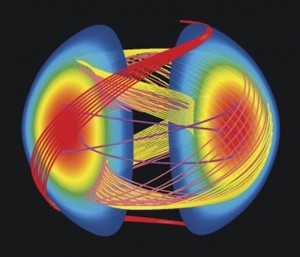
Desktop printing at the nano level
Currently, most nanofabrication is done in multibillion-dollar centralized foundries. Now a desktop nanofabrication tool slightly larger than a printer is said to allow fabrication of high-quality materials and devices, such as processing semiconductors over large areas. Developed by researchers at Northwestern University (Evanston, Ill.), the apparatus consists of easily fabricated beam-pen lithography arrays—structures that consist of an array of polymeric pyramids with a 100-nm aperture at the tip. A digital micromirror breaks a single beam of light into thousands of individual beams, each channeled through the apertures at the tip of each pen. The tool allows rapid processing and fabrication of substrates that span the macro-, micro- and nanoscales all in one experiment. Results of the work were recently published in Nature Communications.
Antifreeze, cheap materials may lead to low-cost solar energy
A process combining some relatively inexpensive materials and the same antifreeze used in automotive radiators from freezing in cold weather may be the key to making solar cells that cost less and avoid toxic compounds, according to scientists at Oregon State University (Corvallis). The researchers determined that ethylene glycol can act as a low-cost solvent in continuous flow reactors for thin-film solar cell production. The research, just published in Material Letters, also concluded this approach will work with copper zinc tin sulfide, a compound of significant interest for solar cells due to its excellent optical properties and the fact that its constituent materials are cheap and environmentally benign. The technology being developed at OSU uses ethylene glycol in meso-fluidic reactors said to offer precise control of temperature, reaction time, and mass transport to yield better crystalline quality and high uniformity of the nanoparticles that make up the solar cell.
Stretchable gold conductor grows its own wires
Finding good conductors that still work when pulled to twice their length has proved to be a tall order—researchers have tried wires in zigzag or spring-like patterns, liquid metals, nanowire networks, and more. But networks of spherical gold nanoparticles embedded in elastic materials may make the best stretchy conductors yet, according to engineering researchers at the University of Michigan (Ann Arbor). “Essentially, the new nanoparticle materials behave as elastic metals,” says Nicholas Kotov, the Joseph B. and Florence V. Cejka Professor of Engineering. “It’s just the start of a new family of materials that can be made from a large variety of nanoparticles for a wide range of applications.” Flexible electronics have a wide variety of possible applications, from bendable displays and batteries to medical implants that move with the body.
Nearly £8 million for Manchester materials research
The University of Manchester (England) recently received funding totaling nearly £8 million for two research projects as part of the British government’s strategy to invest in key technologies. The funding includes £4.3 million to develop advanced materials for demanding industrial environments and £3.3 million, awarded jointly to Manchester and the University of Liverpool, to support development of new energy storage devices that use graphene as a key component. The Manchester-Liverpool consortium is aimed at allowing the transformation of batteries and supercapacitors into a viable option for wide-scale adoption in utility and grid applications.
Titania-based thin films maintain output of crystalline silicon PV cells
Japanese researchers have developed a technology that reduces output decline caused by potential-induced degradation in crystalline silicon solar cells. Scientists from Japan’s Research Center for Photovoltaic Technologies and National Institute of Advanced Industrial Science and Technology, in collaboration with Sustainable Titania Technology Inc., coating the cells’ glass substrate with a thin film of titanium oxide-based composite that suppresses diffusion of sodium and other ions from the glass substrate. Diffusion is considered the major cause of PID, according to the scientists. The technology is expected to improve the reliability of crystalline silicon photovoltaic modules and enhance the long-term reliability of mega solar and other solar power generation systems, installation of which is expected to accelerate in the near future.

